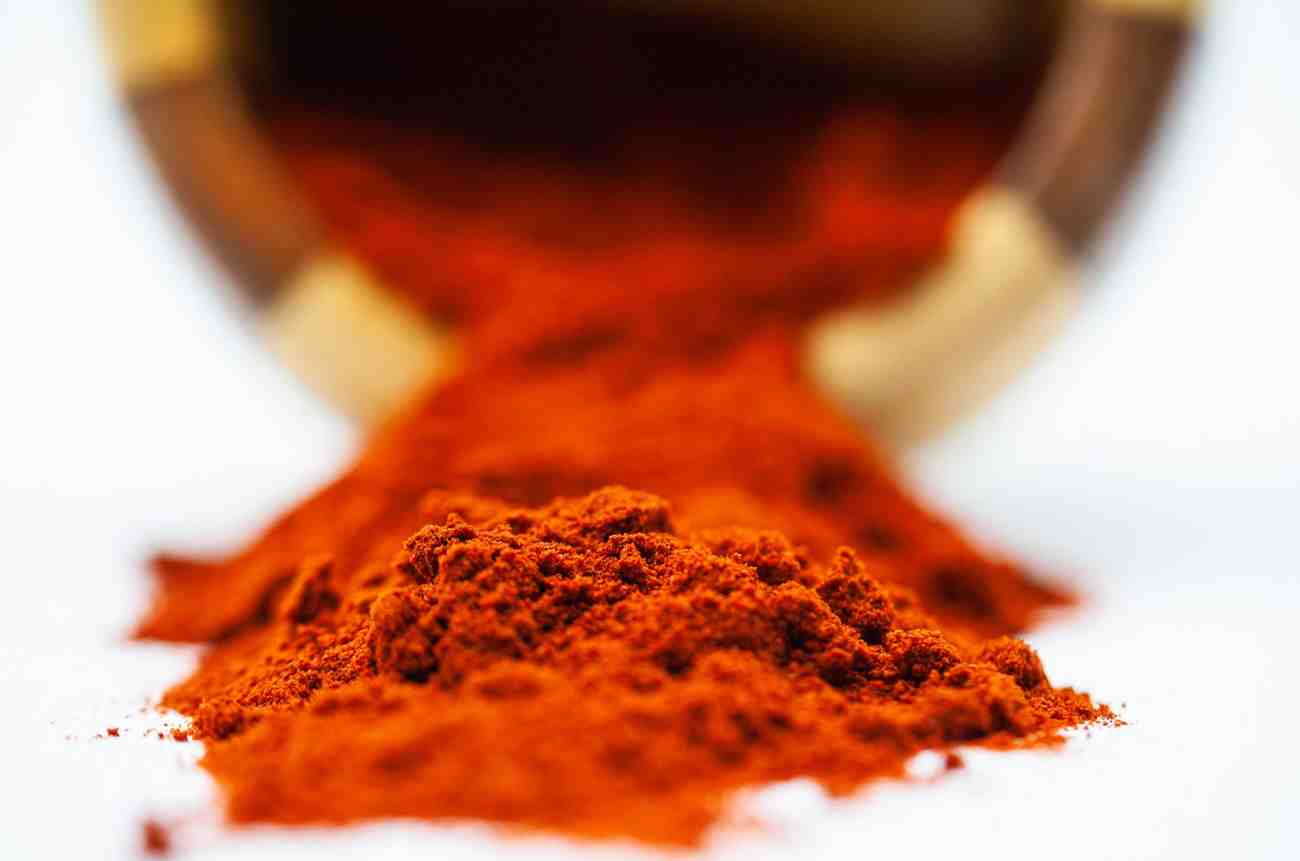Pimentón, also known as Spanish paprika, defines the flavor of many Spanish dishes. This vibrant, red spice, made from dried red peppers, carries a distinctive smoky taste. Originating in La Vera and Murcia regions, pimentón comes in three main types: sweet, bittersweet, and hot. Each type adds a unique note, enhancing dishes with warmth, color, and complexity.
- Versatile and Essential: Spanish cooks use pimentón in stews, sausages, and sauces, appreciating its depth and adaptability.
- Iconic Flavor: The smoky depth, especially from the La Vera variety, has made pimentón a staple in Spanish cuisine. It embodies the essence of traditional Spanish cooking.
As an integral part of Spain’s culinary heritage, pimentón is even protected by Denominations of Origin. This certification guarantees the spice’s authenticity and quality, preserving its cultural and culinary significance.
Origins and History of Pimentón in Spain
Pimentón’s roots trace back to the discovery of the Americas. When Columbus brought red peppers back to Spain, they quickly spread across the country. Initially used for medicinal purposes, these peppers soon found their way into Spanish kitchens. Extremadura proved ideal for growing these peppers, and farmers there perfected the art of drying and grinding them into powder.
Early Use and Discovery in Spain
Here’s how pimentón became central to Spanish cuisine:
- Introduction of Red Peppers: Columbus introduced red peppers to Spain, sparking interest in their culinary and medicinal uses. Farmers soon realized the peppers’ potential, particularly as they began experimenting with drying methods.
- Development of Pimentón Production: The La Vera region’s warm summers and breezy climate made it an excellent location for growing peppers. Local farmers created a smoke-drying technique using oak wood, adding a distinct smoky flavor to the peppers. This method continues today, and La Vera pimentón remains highly prized.
The Role of Denominations of Origin (D.O.)
To protect pimentón’s quality, Spain established Denominations of Origin (D.O.) for this spice. Regions with D.O. certifications, mainly La Vera and Murcia, produce some of the finest pimentón. Only peppers grown and processed in these regions can carry the D.O. label, ensuring authenticity and traditional methods.
- D.O. La Vera: Known for its smoked pimentón, La Vera uses oak wood in its drying process, creating an intense smoky flavor. Spanish cooks often choose this variety for seasoning meats and stews.
- D.O. Murcia: Murcia’s pimentón is not smoked, creating a milder, earthy taste. Sun or hot-air drying preserves its clean, peppery profile, making it ideal for recipes that require a subtler flavor.
These regional distinctions not only guarantee quality but also honor Spain’s deep cultural connection to this spice.
Types of Pimentón and Their Flavor Profiles
Pimentón comes in several types, each offering a unique taste. Knowing these varieties helps cooks select the best type of pimentón for their recipes.
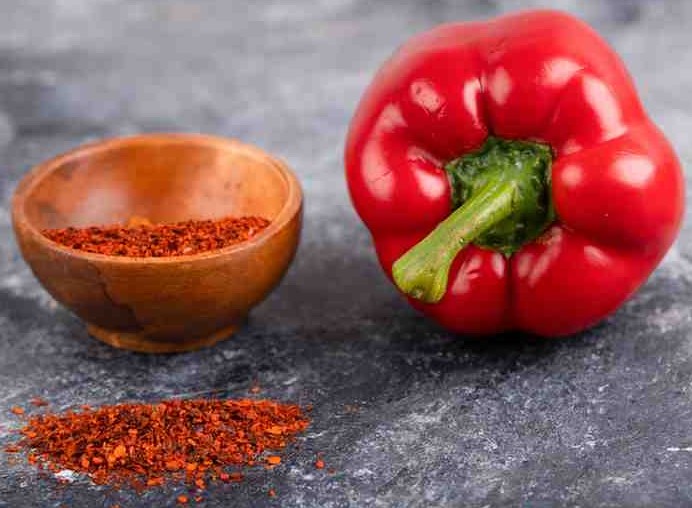
Pimentón Dulce (Sweet Paprika)
Pimentón Dulce, or sweet paprika, has a mild, earthy sweetness. Made from round, mild red peppers, it adds a warm color and subtle flavor without much heat.
- Common Uses: Cooks use Pimentón Dulce in soups, stews, and sauces. Its subtle flavor enhances dishes without overpowering them. It’s also often sprinkled over Spanish tapas, such as patatas bravas or eggs.
Pimentón Agridulce (Bittersweet Paprika)
This bittersweet variety balances sweetness and mild heat. Made from medium-hot peppers, Pimentón Agridulce adds complexity, giving a blend of flavors that works in sauces, meats, and vegetables.
- Common Uses: Bittersweet pimentón appears in sauces, marinades, and stews, where its balanced flavor complements the dish. It’s especially popular in chorizo, where it blends well with the sausage’s richness.
Pimentón Picante (Hot Paprika)
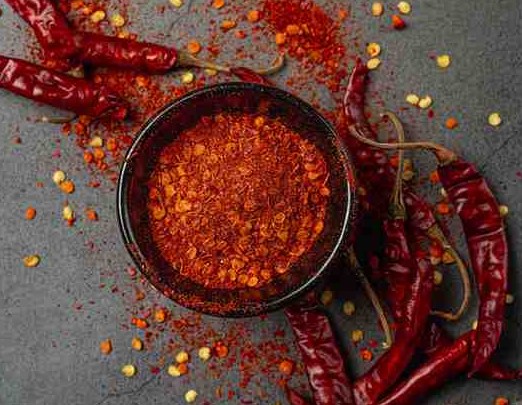
Pimentón Picante, made from hot peppers, brings a bolder, spicier flavor. With a smoky undertone, it’s ideal for those who enjoy a bit of heat in their meals.
- Common Uses: Pimentón Picante is great for adding spice to dishes like Spanish sausages, seafood stews, and other hearty recipes. The hot paprika brings a lively kick that enhances the overall flavor.
Smoked vs. Non-Smoked Varieties
Pimentón can be either smoked or non-smoked, adding a versatile dimension to Spanish cooking:
- Smoked Pimentón: The traditional oak wood drying method in La Vera produces smoked pimentón, which offers a distinctive smoky flavor. This variety adds complexity and depth, ideal for chorizo, seafood stews, and roasts.
- Non-Smoked Pimentón: In Murcia, pimentón is sun-dried or hot-air dried. This approach produces a milder, earthy flavor without the smoke, perfect for dishes that need a more straightforward paprika profile.
These options allow pimentón to adapt to a wide range of recipes, from subtle to intense, smoky to mild.
The Traditional Production Process of Pimentón
The methods for producing pimentón have remained largely unchanged, especially in La Vera, where farmers have perfected the art of smoke-drying. Here’s a look at the journey from field to table.
Growing and Harvesting
In La Vera and Murcia, farmers plant pepper seeds in the spring. By late summer, the peppers reach a rich red color and are ready for harvest. Farmers pick them by hand, carefully selecting only the best peppers.
Drying and Smoking
After harvest, the drying process begins. La Vera’s traditional method involves drying the peppers over oak wood fires in small drying houses. For about two weeks, farmers turn the peppers daily to ensure even drying.
- Why Smoke Matters: The smoke preserves the peppers and infuses them with a deep, smoky flavor. This method defines the taste of La Vera pimentón and distinguishes it from other paprika varieties.
In Murcia, peppers dry under the sun or in hot-air rooms, producing a milder, earthier flavor. This method creates a clean taste without the smokiness of the La Vera variety.
Grinding and Packaging
After drying, the peppers move to mills for grinding. Workers remove the stalks and some seeds, then grind the peppers slowly to maintain their color, flavor, and aroma. The ground pimentón is then carefully packaged to preserve its freshness.
- Freshness Matters: High-quality pimentón is packed in airtight tins or bags to lock in its vibrant color and taste. When stored correctly, pimentón retains its flavor for up to two years.
This traditional production process guarantees that each type of pimentón delivers authentic Spanish flavor, making it a cherished ingredient worldwide.
Culinary Uses of Pimentón in Spanish Cuisine
Pimentón’s smoky, rich flavor makes it essential in both traditional and modern Spanish cooking. From classic dishes to creative recipes, pimentón adds depth and a signature Spanish warmth to each dish.
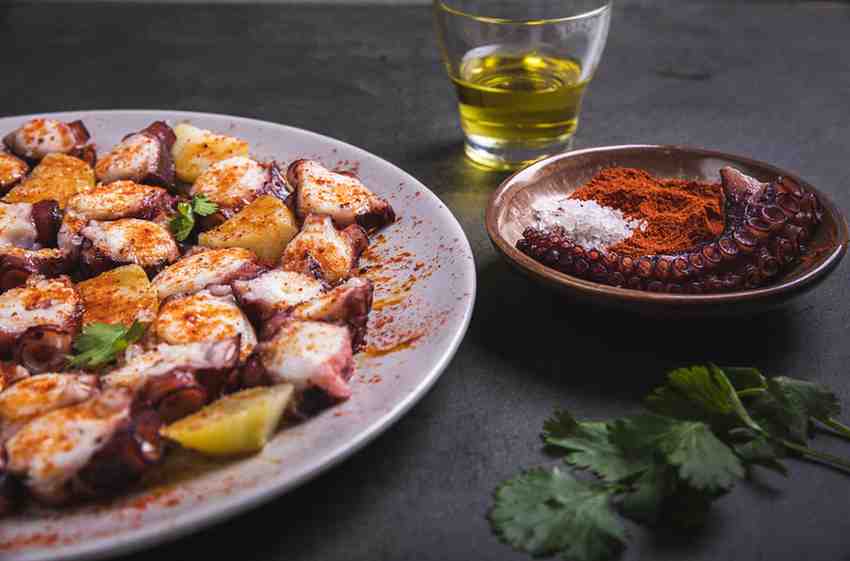
Traditional Spanish Dishes Featuring Pimentón
Many beloved Spanish dishes owe their distinctive flavor to pimentón. Here are a few classics where pimentón truly shines:
- Chorizo:
- This iconic Spanish sausage owes its vibrant color and smoky, mildly spicy flavor to pimentón dulce (sweet paprika) or pimentón agridulce (bittersweet paprika). Along with pimentón, chorizo is often seasoned with garlic and a touch of oregano,
- Paella:
- In Spain’s renowned rice dish, pimentón adds a deep, earthy note that complements a mix of seafood, chicken, or rabbit. Additionally, saffron is a prized ingredient that gives paella its golden color and subtle floral aroma, while garlic and rosemary can be used to add layers of Mediterranean flavor.
- Pulpo a la Gallega (Galician Octopus):
- In this Galician specialty, tender octopus is sprinkled with pimentón and drizzled with extra virgin olive oil, delivering a smoky, slightly peppery taste. Sea salt is also added to highlight the natural flavor of the octopus.
- Patatas Bravas:
- Crispy fried potatoes topped with a spicy tomato sauce make Patatas Bravas a popular tapa. Here, pimentón is blended with cayenne pepper for extra heat and garlic for depth, creating a fiery sauce that coats each potato. In some recipes, a touch of parsley is sprinkled on top for a fresh garnish.
Modern and Creative Uses for Pimentón
Beyond traditional recipes, pimentón has become a versatile ingredient in contemporary cooking. Here are some creative ways to incorporate it:
- Roasted Vegetables: Toss vegetables like bell peppers, potatoes, and zucchini with pimentón before roasting. The smoky paprika adds warmth, enhancing the natural flavors of the vegetables.
- Popcorn and Nuts: For a quick snack, sprinkle pimentón on popcorn or roasted almonds. This twist on traditional snacks brings a touch of Spanish flavor to each bite.
- Marinades and Rubs: Use pimentón as part of a spice rub or marinade for meats and seafood. Combined with olive oil, garlic, and herbs, it brings a unique, smoky complexity to grilled or baked dishes.
- Soups and Stews: Add pimentón to hearty soups or stews for extra depth and richness. A spoonful stirred into vegetable or lentil soup enhances flavor, making each bowl more robust.
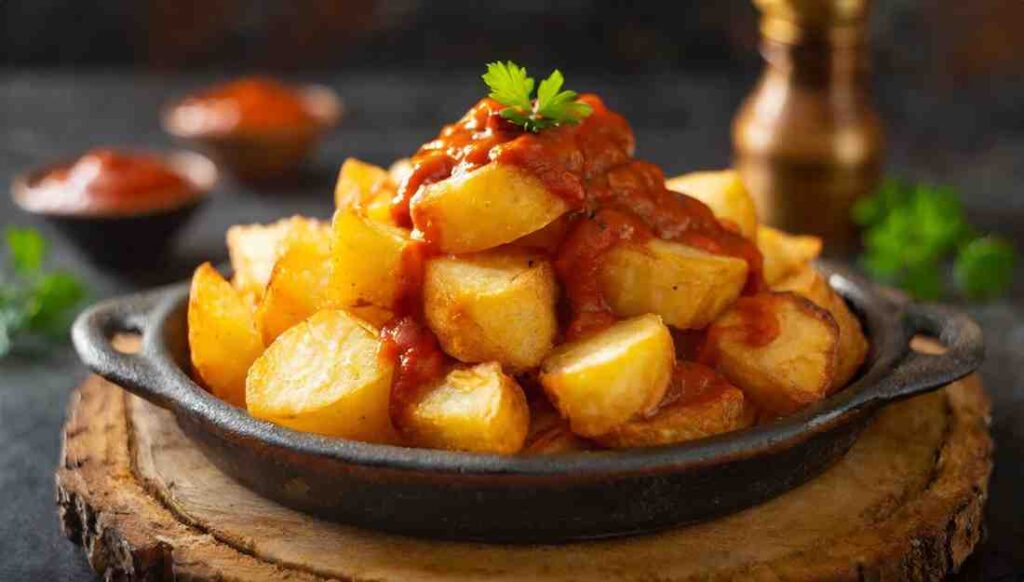
Health Benefits of Pimentón
In addition to its culinary value, pimentón offers several health benefits. The vibrant red peppers used in pimentón are rich in vitamins and antioxidants, supporting overall wellness.
Key Health Benefits of Pimentón
Each spoonful of pimentón provides more than just flavor; it also brings valuable nutrients and health-promoting compounds to meals.
- Antioxidant Properties:
- Pimentón is high in antioxidants, particularly capsanthin and carotenoids, which help protect cells from oxidative damage. Antioxidants play a role in supporting cellular health and reducing signs of aging.
- Rich in Vitamins:
- Packed with vitamins A, E, and C, pimentón supports immune function, skin health, and eye health. These vitamins also aid in combating inflammation.
- Anti-Inflammatory Effects:
- Compounds in pimentón, especially from red peppers, help reduce inflammation, benefiting those with conditions like arthritis. Regularly adding pimentón to meals can be a flavorful way to support joint and cardiovascular health.
These health benefits make pimentón a beneficial addition to daily meals, adding both flavor and nutritional value.
Incorporating Pimentón into a Healthy Diet
Using pimentón in a balanced diet is easy. It pairs well with nutrient-dense foods like vegetables, lean proteins, and whole grains. By seasoning meals with pimentón, you can enjoy its benefits while keeping dishes nutritious and flavorful.
FAQs About Pimentón
Pimentón is popular in Spanish cooking but often raises questions, especially for those new to this spice. Here are answers to some frequently asked questions:
What types of pimentón are there?
- Pimentón comes in three main types: dulce (sweet), agridulce (bittersweet), and picante (hot). Each has a unique flavor profile, allowing it to complement various dishes.
Is pimentón spicy?
- Pimentón picante is the spiciest type, while pimentón dulce has a milder, sweet flavor. Bittersweet pimentón (agridulce) falls in between, offering a balanced blend of sweetness and spice.
How is pimentón different from regular paprika?
- Spanish pimentón, especially from La Vera, is often smoked, giving it a rich, smoky flavor that regular paprika typically lacks. Pimentón’s flavor profile is also more complex, making it distinct from other types of paprika.
How should pimentón be stored?
- Store pimentón in an airtight container in a cool, dark place. This helps preserve its color, flavor, and nutritional properties. When properly stored, pimentón can last up to two years.
Can pimentón be used as a substitute for other spices?
- Yes, pimentón can replace regular paprika in many recipes. Its smoky flavor can also substitute for liquid smoke or chipotle powder, adding depth to dishes that benefit from a hint of smokiness.
These FAQs provide helpful insights for using pimentón in the kitchen, guiding both novice and experienced cooks.
Tips for Using Pimentón in Cooking
Getting the most out of pimentón means knowing how to use it effectively. Here are some tips for incorporating this iconic spice into your cooking:
- Choose the Right Type: Pick sweet, bittersweet, or hot pimentón based on the flavor you want. Sweet pimentón adds color and mild flavor, while hot pimentón brings a kick. Bittersweet offers a balanced blend for versatile use.
- Store Properly: Keep pimentón in an airtight container away from light. This preserves its vibrant color and robust flavor, extending its shelf life.
- Cook at Lower Temperatures: To avoid burning, add pimentón at a lower temperature or incorporate it toward the end of cooking. This approach helps release its aroma without creating a bitter taste.
- Combine with Olive Oil: Mixing pimentón with olive oil enhances its flavor, making it perfect for marinades, dressings, and drizzles over tapas.

